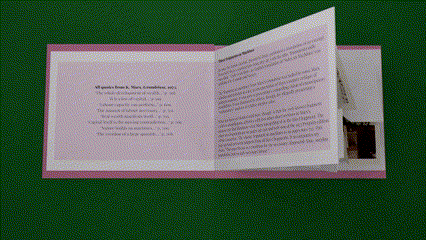Every pop-up must span a gully. — Duncan Birmingham
The gully I aim to span with my pop-ups is the imaginary separation between the interior world of the mind and the exterior world of people and things. In One-Way Street, Walter Benjamin wrote about “the archaic stillness of the book” and the slim chance that a child could penetrate it after having been exposed to “such a blizzard of changing, colourful, conflicting letters” in an environment dominated by advertising. Maybe I take Benjamin literally when I assimilate that blizzard into the “three-dimensional writing” of my books.
In a famous passage from Beyond the Pleasure Principle, Sigmund Freud told about a game played by his one-and-a-half-year-old grandson, who “was not at all precocious in his intellectual development.” The child repeatedly threw a wooden toy on a piece of string into his crib and then reeled it back out again, “with a joyful ‘da’.” This child’s game of fort/da was a solitary version of peek-a-boo that Freud analyzed as a way of transforming a distressing experience — the absence of the mother — into a pleasurable one through repetition and play.
Peek-a-boo represents a major intellectual development for the child, which Jean Piaget termed “object permanence.” It is associated with the intense delight of mastery. Opening and closing a pop-up book is a game of peek-a-boo.
A pop-up is a machine. Technically, the foundation shapes of v-fold and box-fold mechanisms are four-lever linkages whose movements are dictated by the relationship between fulcrums located at the folds and beams of stiff cardstock paper. The gully a pop-up spans is a fulcrum for the levers that lift it.
The pop-up book is thus a happiness machine that leverages the primal joy of cognitive achievement. The 2002 BBC documentary, The Century of the Self, attributed a quote about advertising and “happiness machines” to early 20th century U.S. President Herbert Hoover:
You have taken over the job of creating desire and have transformed people into constantly moving happiness machines — machines which have become the key to economic progress.
I have been unable to find any confirmation that Hoover actually said that from any source prior to the documentary. What Hoover did say, though, in an address to the Association of National Advertisers in 1930, was similar in substance if not in exact wording:
The purpose of advertising is to create desire, and from the torments of desire there at once emerges additional demand and from demand you pull upon increasing production and distribution.
Both quotations refer to the “creation of desire,” which is an untenable claim. “Desire,” wrote Baruch Spinoza, “is the essence of a man, that is, the endeavour whereby a man endeavours to persist in his own being.” There is no need to create desire, only a will to channel it toward some particular end — the purchase of more commodities. Likewise, there is also no need to create a desire for happiness because that is virtually the definition of desire, according to the philosophers. Advertising is not aimed at creating desire or happiness but at confining desire to consuming the products of industry.
Channelling human desire into consumerism recalls the stream flow and erosion dynamics of the gully. Erosion washes away topsoil, pollutes the waterways, and damages the environment. Changing climate transforms the gullies into dry gulches, terrain for wildfires, flash floods, and ambushes. We can all lament the widening social and ecological chasm in various ways. The point is to span it.
On Marx’s Fetters with links to related posts
Marx’s Fetters: A remedial reading spans the gully between his 1857-58 manuscripts and his 1859 preface to A Contribution to the Critique of Political Economy. The latter book was published in 1859; the manuscripts were not published in a widely-available edition until 1953, almost a century after they were written. My contention is that the 1859 preface was a summary of the earlier manuscripts that omitted potentially censorable conclusions, with an eye to getting past the Prussian censors. My pop-up spans the gully of that censorship.
Marx’s Fetters was the fifth in a series of similarly formated and themed pop-ups books that I began in May of 2020 during the Covid isolation. My son, Reuben animated the first four books, which used only two pop-up mechanisms, in repeated alternation. In Marx’s Fetters, each pop-up is unique.
The fourth book in the series was Three Fragments on Machines, based on my contention that the famous “Fragment on Machines” of notebook VII in Marx’s Grundrisse could not be fully comprehended as a stand alone and was intimately related to two earlier fragments in notebooks IV and VI. I only made a few copies of that one because I felt that it was too text heavy. Marx’s Fetters started out as a concept for a less dense reboot of Three Fragments. But the images and text fragments asserted themselves as a distinct book.
Between making Three Fragments and Marx’s Fetter’s, I worked on a commission which enabled me to buy a cutting and scoring machine and taught me to have my pages professionally printed. Although I played around a bit with animating Marx’s Fetters, I concluded that an animation would have to be something more than a moving picture of turning pages.
Ideally, a pop-up book needs no “artist’s statement” placard. There is even an introduction in the book itself. But it somehow dawned on me to expand on the issues that are either implicit or obscure in the book. This turned into a three-part essay that includes Fetters on the Development of the Productive Forces, The Realm of Freedom and the Dictatorship of the Proletariat, and THE ACCUMULATION OF CAPITAL IS VERY LIMITED….
Radical social ideas are radical not because they express the demand for some imagined desirable society, not because they protest against some inequity in the present order. Their radicalness derives from their ability to express the repressed potential of the present social order, from their accuracy in pointing to the possibilities which the status quo negates. — Martin Nicolaus, “The contradiction of advanced capitalist society and its resolution” 1966.











